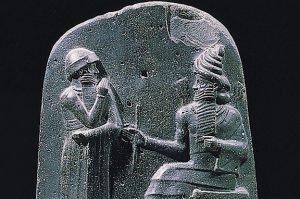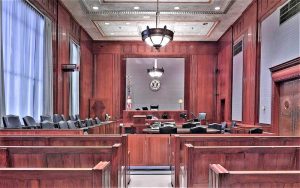Code of Hammurabi
The law of Talion was clear, when committing a crime that violated the Code of Hammurabi, payment was made with the death of the accused, hence the famous quote: "eye for eye, tooth for tooth". Represented as the antecedent to many modern legal concepts, this code has undergone changes throughout history to create a balance with its laws and society. One of its most radical and famous laws was: "If a lord accuses another lord, and files against him a charge of murder, but cannot prove it, his accuser will be punished with death. This was the first written law of the Code of Hammurabi.

Related topics
Quid pro quo
What is the Code of Hammurabi?
The Code of Hammurabi is the first grouping of laws in history entrusted by God Marduk to promote and govern the welfare among human beings.
About the Code of Hammurabi
Through its set of established laws and regulations, the Code of Hammurabi consisted of controlling, organizing, and governing 18th century society in ancient Mesopotamia, where there was a punishment for exchange equivalence.
Characteristics of the Code of Hammurabi
The Code of Hammurabi is governed by three main features:
- The law of Talion: “An eye for an eye, a tooth for a tooth”. In other words, everything the citizen did, he had to accept in the same way.
- Semiprivate justice: The victim had to bring the accused to justice, the court acted as arbitrator, the officers were present at the execution of the sentence.
- Inequality before the law: The sentence varied according to the type of person in which the individual was ruled (noble, freeman and slave).
To which culture did it belong?
The Code of Hammurabi belonged to the culture of the ancient Orient, in the year 1750-1790 B.C., in the city of Babylon.
History of the Code of Hammurabi
In ancient Eastern culture, it was the gods who dictated the laws to men for handling a deeper sense of spirituality and balance, so the laws have a divinity character. In any case, it is the God Samash, the mighty Sun God and God of justice, who grants the laws to King Hammurabi of Babylon (1750-1790 B.C.).
In fact, before Hammurabi came to power, it was the priests of God Samash who fulfilled the function as judges, but Hammurabi established that only the key royal officials would apply this work, thus limiting the power they exercised from the priests and gaining strength for the monarch himself.
The code of law unifies the different codes existing in the cities of the Babylonian empire. With this, it seeks to establish applicable laws in all cases, and thus prevent everyone from “taking justice into their own hands“, because without a written law that judges could apply in a mandatory way, it was easy for each one to act as they pleased for that time.
In the Code of Hammurabi there is no distinction between civil and criminal law, i.e., laws are applied that regulate different situations of daily life and laws that punish crimes committed. It employs the regulation of trade, unpaid work, different types of loans, rents, inheritances for each family, divorces, property, death penalties for crimes of robbery, murder, among others.
Most of the penalties written into the Code of Hammurabi are pecuniary (fines or warnings), although there is also the penalty of mutilation and even the death penalty. In many cases, the law chooses to apply Talion’s motto, that is, to do to the aggressor exactly what he did to his victim, this worked as long as both were of the same “category“.
The Talion law only applies between individuals of the same category. If the aggressor is a higher category than the assaulted (victim), the Talion law does not apply, but rather a pecuniary sentence is applied.
In the code, there is the presence of three ” men’s, categories “: the free ones, the slaves and an intermediate category called “muskenu” that could refer to the servants.
On what principle was Hammurabi’s Code based?
His ideal was to base itself on the law of Talion, as a symbol of equivalence of exchange or equilibrium. That provided control through its laws to control society.
Law
Here are the most relevant laws of the Code of Hammurabi:
- “If a gentleman accuses another gentleman and files a murder charge against him, but cannot prove it, his accuser will be punished with death”.
- “If a lord accuses another lord of witchcraft, but cannot prove it, the accused of witchcraft will go to the river and must throw himself into the river. If the river succeeds in dragging him, his accuser will take away his property. But if this lord has been purified by the river coming out of it safe and well, the one who accused him of witchcraft will be punished with death, and the one who threw himself into the river will take away the property of his accuser”.
- “If a gentleman appears in a process to present a false testimony and cannot prove the word that he has said, if the process is a capital one such gentleman, will be punished with death”.
- “If he presents himself to testify falsely, in a process of grain or silver, he will suffer in its entirety the penalty of this process”.
- “If a judge has tried a case, pronounced a sentence, and deposited the sealed document, if he then changes his decision, it will prove to him that the judge changed his sentence and will pay up to twelve times the amount of what motivated the case. In addition, publicly, he will be removed from his seat of justice and will not return again. He will never be able to sit with the judges in a trial again”.
- “If a lord steals religious or state property, that lord will be punished with death. In addition, the one who received the stolen goods from his hands will also be punished with death”.
- “If, by the hand of the son of a lord or of a slave of a private person, a lord has acquired or received in custody silver or gold, a slave, an ox or a sheep or a donkey, or whatever it is, without witnesses or a contract, such lord is a thief: in such cases, he shall be punished with death”.
- “If a lord steals an ox, a lamb, a donkey, a pig, or a boat, if that which is stolen belongs to religion or if it belongs to the state, he shall restore it up to thirty times its value; if it belongs to a subordinate, he shall restore it up to ten times. If the thief has nothing with which to restore, he shall be punished with death”.
- “If a lord, having lost an object, finds his lost object in the possession of another lord; if the lord in whose possession the lost object was found declares: “A seller sold it to me, I bought it in the presence of witnesses”; if on the other hand, the owner of the lost object declares: “If, on the other hand, the owner of the lost object presents witnesses who testify about the lost object, then the judges will consider the evidence, and the witnesses in whose presence the purchase was made, together with the witnesses who testify about the lost object, will declare what they know before God. And since the seller was the thief, he will be punished with death. The owner of the lost object will recover his lost object. The buyer will recover the silver from the seller”.
- “If the buyer has not presented the seller who sold him (the object), or the witnesses in whose presence the purchase was made, and the owner of the lost thing presents witnesses who testify about his lost thing, the buyer was the thief: he will be punished with death. The owner of the lost thing will recover his lost property”.
Women’s rights
On women’s rights in the Code of Hammurabi, here are some quotes:
- Law 151: “If a woman who lives in a man’s house, her husband has promised her that she will not be taken by her creditors and has had a note given in this respect, if this man before marrying had debts, the creditor will not take the wife; and if the woman, before entering the man’s house, had debts, the creditor of the debt will not take her husband”.
- Law 152: “If, after she entered the man’s house, a debt compels them, they shall pay the merchant both”.
- Law 153: “If one man’s wife has him killed for another man’s sake; he will go to the gallows”.
- Law 154: “If one knew his daughter carnally, he shall be expelled from the city”.
Children’s rights
- “If a man knows his daughter carnally, that man will be banished from the city.”
- “If a man wants to disinherit his son and says before the judges, “I want to disinherit my son,” the judges will determine the facts of his case and, if he has not demonstrated the reasons for disinheritance, the father cannot disinherit his son”.
Importance of the Code of Hammurabi
The Code of Hammurabi has a wide meaning, as it attracts with it, laws and organizations that venerate and protect the welfare of citizens, as well as pioneering inspiration in later centuries, for the creation of laws, in all nations of the world.
Curiosities
- It was created to humiliate the wicked and unjust.
- It is the first known legal body.
- Code of Hammurabi referred to water as the highest expression of purity, which showed its innocence.
How to cite this article?
Briceño V., Gabriela. (2019). Code of Hammurabi. Recovered on 3 January, 2025, de Euston96: https://www.euston96.com/en/code-of-hammurabi/









